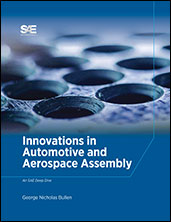Book

Innovations in Automotive and Aerospace Assembly
2018-03-23
Up until the last two decades, aluminum in airplanes and steel in automobiles were the primary materials used to produce these two complex machines. These metal-to-metal assemblies, and specifically the same-type metal-to-metal assemblies, have resulted in distinct manufacturing process advantages over decades of production. However, advances in material types have driven manufacturing to adapt and align the fabrication and assembly processes to continue to facilitate a quality product that is reliable, can be manufactured at a price point that is affordable and be manufactured in quantities that can be widely distributed. Dissimilar metal and composite material assemblies are now requiring highly complex manufacturing processes. Innovations in Automotive and Aerospace Assembly addresses how these new, disruptive materials usage are changing the manufacturing and production processes for the transportation industries.
